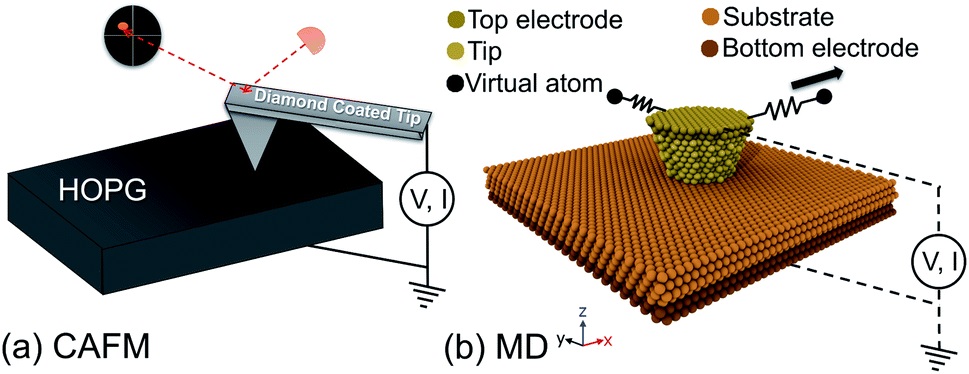Friction in nanoscale contacts is determined by the size and structure of the interface that is hidden between the contacting bodies. One approach to investigating the origins of friction is to measure electrical conductivity as a proxy for contact size and structure. However, the relationships between contact, friction and conductivity are not fully understood, limiting the usefulness of such measurements for interpreting dynamic sliding properties.*
In their study “Insights into dynamic sliding contacts from conductive atomic force microscopy” Nicholas Chan, Mohammad R. Vazirisereshk, Ashlie Martini and Philip Egberts used atomic force microscopy (AFM) to simultaneously acquire lattice resolution images of the lateral force and current flow through the tip–sample contact formed between a highly oriented pyrolytic graphite (HOPG) sample and a conductive diamond AFM probe to explore the underlying mechanisms and correlations between friction and conductivity. Both current and lateral force exhibited fluctuations corresponding to the periodicity of the HOPG lattice.
Unexpectedly, while lateral force increased during stick events of atomic stick-slip, the current decreased exponentially.*
The results presented in the study by Nicholas Chan et al. confirm that the correlation between conduction and atom–atom distance previously proposed for stationary contacts can be extended to sliding contacts in the stick-slip regime.*
A NANOSENSORS™ conductive diamond coated AFM probe CDT-CONTR was used to obtain all experimental data presented in their manuscript.*

Figure 1 (a) from “Insights into dynamic sliding contacts from conductive atomic force microscopy” by Nicholas Chan et al:
A schematic of the experimental setup is shown in Fig. 1(a). The experiment was conducted using an ultra-high vacuum (UHV)AFM at room temperature at a pressure of <1109Torr. A doped diamond coated cantilever (NANOSENSORS CDT-CONTR) with a normal bending spring constant of 0.86 N m1and lateral spring constant of 10 N m1was used to obtain all experimental data presented in this manuscript.
*Nicholas Chan, Mohammad R. Vazirisereshk, Ashlie Martini and Philip Egberts
Insights into dynamic sliding contacts from conductive atomic force microscopy
Nanoscale Advances., 2020, Advance Article
DOI: 10.1039/d0na00414f
Please follow this external link to read the whole article: https://pubs.rsc.org/en/content/articlepdf/2020/na/d0na00414f
Open Access: The article “Insights into dynamic sliding contacts from conductive atomic force microscopy” by Nicholas Chan, Mohammad R. Vazirisereshk, Ashlie Martini and Philip Egberts is licensed under a Creative Commons Attribution 3.0 International License, which permits use, sharing, adaptation, distribution and reproduction in any medium or format, as long as you give appropriate credit to the original author(s) and the source, provide a link to the Creative Commons license, and indicate if changes were made. The images or other third party material in this article are included in the article’s Creative Commons license, unless indicated otherwise in a credit line to the material. If material is not included in the article’s Creative Commons license and your intended use is not permitted by statutory regulation or exceeds the permitted use, you will need to obtain permission directly from the copyright holder. To view a copy of this license, visit http://creativecommons.org/licenses/by/3.0/.